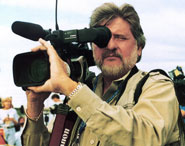|
|
Welcome to the February issue of The Digital Journalist, the online magazine for visual journalism.
After 10 years, this issue marks our first major redesign.
When we started The Digital Journalist, the idea was that we would become the 21st-century version of the old LIFE magazine. We imagined bringing you the world, the stories of the photographers who cover the great events of our time, and to lead the way to changes in technology that would redefine photojournalism.
We have done all of that. But the original concept of "magazine" has become outdated. LIFE is dead. The last stake was driven into its heart by Time Inc. last fall, when they abandoned what was an embarrassment, a "pamphlet" that was included in a limited number of Sunday newspapers.
We now need to move on.
You will note, as you look at our new format, that the "cover" has gone. I feel badly about that. I loved it, as somebody who has contributed so many covers to TIME, but it was an anachronism. We are a Web publication, and we want to allow our readers to move quickly through our screens.
Dina Richards, who is currently the Director of Online Media at WHRO, a PBS and NPR affiliate station in Norfolk, Va., created our stylish redesign. She worked closely with our Webmaster, Mark Wilkie.
This redesign is an ongoing process. What you see is the most important part, the template for future issues. By next month we will allow you to make comments on every story. We are also redesigning our features to allow for HD streaming video.
Let us know how you like the redesign.
Our cover story for this month (NO! STOP IT DIRCK! THERE IS NO COVER!) is Douglas Kirkland's FREEZE FRAME. Douglas, who has been featured previously on The Digital Journalist, has spent five decades covering the motion picture industry. This is a very personal, behind-the-scenes look at the stars who have captivated our hearts. From Brigitte Bardot to Marilyn Monroe, from John Wayne to Jessica Alba, Douglas shares his special Tinseltown moments with us.
Our other feature is STORM CHASER by Jim Reed, one of America's most successful and award-winning weather photographers. No mere thrill-seeker, Jim is a veteran 'storm chaser' who has spent nearly two decades photographing some of the most powerful – and sometimes deadly – meteorological phenomena in the world, from tornadoes and blizzards to 15 hurricanes, including Katrina. The issue of global warming is becoming increasingly important to us all. Jim explains why.
Our editorial, THE PERFECT STORM HITS NEWSPAPERS, is a fitting follow-up to Jim Reed's essay. We have been saying for at least nine years that newspapers would have to adjust to the new realities imposed on them by the Internet. On Feb. 7, The Capital Times in Madison, Wis., announced that this spring it would cease publishing its daily print edition, while "dramatically enhancing" its Web site. This is the first break in the dam that in the months ahead will probably sweep many newspapers away with it. Our Ron Steinman recently conducted a fascinating interview with Dr. Hany Farid of Dartmouth College, who has developed software for the increasingly relevant science of Digital Forensics. Dr. Farid discusses the ramifications of how photos, and to a degree, video, can undergo manipulation in this era of 2.0, and as we slide ever more quickly into 3 The photographic industry has lost two of its most beloved people in the past month. We pay tribute to Henry Froehlich and Bernie Boston. They will be missed.
For February we have two "Dispatches" about the death of Benazir Bhutto. The first, by John Moore, was widely seen in newspapers and on television. After her rally, Moore was ready to leave, only to be surprised to see Bhutto stand up in her automobile. Photographer Adam Dean experienced the same surprise. He followed her car to the hospital, not realizing she was dead. We are fortunate to have two different reactions to the initial burst of gunfire and the subsequent events. The third dispatch, by Spencer Platt, is from a place known as CAR – the Central African Republic. This benighted part of Africa has a life expectancy of only 39 and is virtually ignored by media and unknown to much of the world's public.
"E-Bits" Editor Beverly Spicer writes this month about adventures in cyberspace and how it might change our consciousness. She presents two galleries of amazing photos of the natural world, and two video clips about more esoteric things connected to the abstract world of ideas and imagination.
The pity of it all is that word editors rarely understand the perimeters under which their photography employees have to work. They often come up with changes that they feel will improve their pages. Such was the case with the managing editor of Newsday's Women's Pages when he came back to the Photo Dept. and declared, "I don't want any more posed pictures." You can read what happened in this month's "Assignment Sheet" in Dick Kraus' "Through A Lens Dimly" feature, 'Newsday Goes to the Party.'
Our regular contributors, Ron Steinman, Bill Pierce, Terry Heaton, PF Bentley, Mark Loundy and Chuck Westfall, are back in their usual posts. Jim Gabour, too, is back this month, with a lively account of Mardi Gras in New Orleans. And Eileen Douglas returns to write about what people come to expect from the unexpected when big news events occur.
We hope you enjoy this new, redesigned version of The Digital Journalist. Dirck Halstead |

